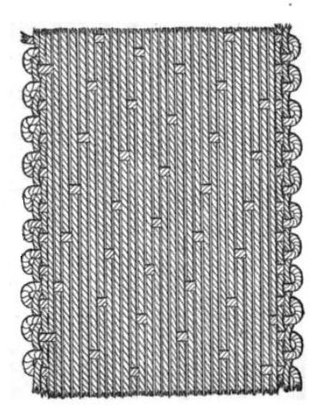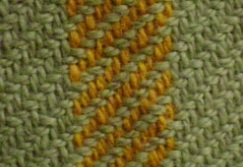
Velvet is a type of woven fabric with a dense, even pile that gives it a distinctive soft feel. By extension, the word velvety means "smooth like velvet". Historically, velvet was typically made from silk. Today, velvet can be made from silk, linen, cotton, wool, synthetic fibers, silk-cotton blends, or synthetic-natural fiber blends. Including these materials in the production can make it more affordable and durable.

A satin weave is a type of fabric weave that produces a characteristically glossy, smooth or lustrous material, typically with a glossy top surface and a dull back; it is not durable, as it tends to snag. It is one of three fundamental types of textile weaves alongside plain weave and twill weave.

Poplin, also called tabinet, is a fine wool, cotton or silk fabric that has a vertical warp and a horizontal weft. Nowadays, the name refers to a strong material in a plain weave of any fiber or blend, with crosswise ribs that typically give a corded surface.

Moleskin is a heavy cotton fabric, woven and then shorn to create a short, soft pile on one side. The feel and appearance of its nap is suede-like, less plush than velour and more like felt or chamois. The word is also used for clothing made from this fabric. Clothing made from moleskin is noted for its softness and durability. Some variants of the cloth are so densely woven as to be windproof.

Twill is a type of textile weave with a pattern of diagonal parallel ribs. It is one of three fundamental types of weave, along with plain weave and satin. It is made by passing the weft thread over one or more warp threads then under two or more warp threads and so on, with a "step," or offset, between rows to create the characteristic diagonal pattern. Because of this structure, twill generally drapes well.

In the manufacture of cloth, warp and weft are the two basic components in weaving to transform thread and yarn into textile fabrics. The vertical warp yarns are held stationary in tension on a loom (frame) while the horizontal weft is drawn through the warp thread. In the terminology of weaving, each warp thread is called a warp end ; a pick is a single weft thread that crosses the warp thread.

Damask is a reversible patterned fabric of silk, wool, linen, cotton, or synthetic fibers, with a pattern formed by weaving. Damasks are woven with one warp yarn and one weft yarn, usually with the pattern in warp-faced satin weave and the ground in weft-faced or sateen weave. Twill damasks include a twill-woven ground or pattern.

A bed sheet is a rectangular piece of cloth used either singly or in a pair as bedding, which is larger in length and width than a mattress, and which is placed immediately above a mattress or bed, but below blankets and other bedding. A bottom sheet is laid above the mattress, and may be either a flat sheet or a fitted sheet. A top sheet, in the many countries where they are used, is a flat sheet, which is placed above a bottom sheet and below other bedding.

Double cloth or double weave is a kind of woven textile in which two or more sets of warps and one or more sets of weft or filling yarns are interconnected to form a two-layered cloth. The movement of threads between the layers allows complex patterns and surface textures to be created.

Crêpe, also spelled crepe or crape, is a silk, wool, or synthetic fiber fabric with a distinctively crisp and crimped appearance. The term "crape" typically refers to a form of the fabric associated specifically with mourning. Crêpe was also historically called "crespe" or "crisp".

Textile manufacturing is a major industry. It is largely based on the conversion of fibre into yarn, then yarn into fabric. These are then dyed or printed, fabricated into cloth which is then converted into useful goods such as clothing, household items, upholstery and various industrial products.

Plain weave is the most basic of three fundamental types of textile weaves. It is strong and hard-wearing, and is used for fashion and furnishing fabrics. Fabrics with a plain weave are generally strong, durable, and have a smooth surface. They are often used for a variety of applications, including clothing, home textiles, and industrial fabrics.

Silk In India, about 97% of the raw mulberry silk is produced in the Indian states of Karnataka, Andhra Pradesh, Tamil Nadu and West Bengal. Mysore and North Bangalore, the upcoming site of a US$20 million "Silk City", contribute to a majority of silk production. Another emerging silk producer is Tamil Nadu in the place in where mulberry cultivation is concentrated in Salem, Erode and Dharmapuri districts. Hyderabad, Andhra Pradesh and Gobichettipalayam, Tamil Nadu were the first locations to have automated silk reeling units.
The manufacture of textiles is one of the oldest of human technologies. To make textiles, the first requirement is a source of fiber from which a yarn can be made, primarily by spinning. The yarn is processed by knitting or weaving, which turns yarn into cloth. The machine used for weaving is the loom. For decoration, the process of colouring yarn or the finished material is dyeing. For more information of the various steps, see textile manufacturing.

Waffle fabric, also known as honeycomb fabric, has raised threads that form small rectangles. It can be made by either weaving or knitting. Waffle weave is a further exploitation of plain weave and twill weave which produces a three-dimensional effect. The combination of warp and weft floats creates the structure. It is woven partly on tabby areas surrounded by ridges of long floats. The weave consists of warp and weft floats arranged around a plain weave center. The warp and weft threads are interlaced and floating in a way that creates small square ridges and hollows in the fabric in a regular pattern.

Shantung is a type of silk plain weave fabric historically from the Chinese province of Shandong. It is similar to Dupioni, but is slightly thinner and less irregular. Shantung is often used for bridal gowns.
Momie cloth is a pebble-surfaced crêpe structure made of any natural or synthetic yarns. Momie crepe is a light weight material made of cotton.

Brocatelle is a silk-rich fabric with heavy brocade designs. The material is characterized by satin effects standing out in relief in the warp against a flat ground. It is produced with jacquard weave by using silk, rayon, cotton, or many synthetic yarns.
Faille is a type of cloth with flat ribs, often made in silk. It has a softer texture than grosgrain, with heavier and wider cords or ribs. Weft yarns are heavier than warp, and it is manufactured in plain weaving. It was especially popular in the 19th century.

The swivel weave is a weaving technique that incorporates a decorative element into the fabric by using small shuttles that insert additional weft thread around selected warp threads, while the main weft thread forms the fabric's structure. This method differs from the plain weave, which lacks this decorative aspect.

















